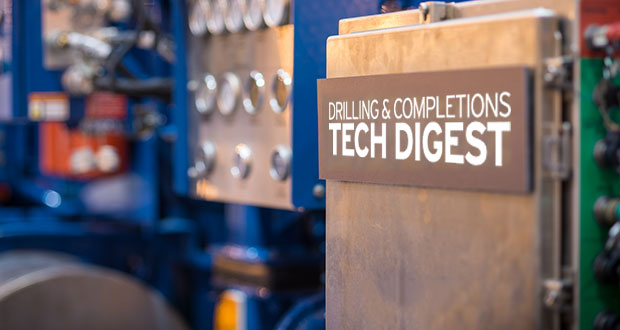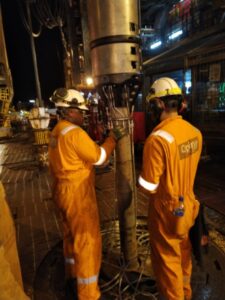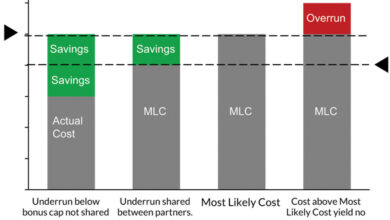Drilling & Completion Tech Digest

Remotely controlled well completion on SNEPCo’s Bonga field offshore Nigeria is a first in African waters
Shell Nigeria Exploration and Production Company (SNEPCo) has successfully completed the first remotely controlled well completion operation offshore Nigeria.
The operation was performed at the Bonga field, in 1,060-m water depth. It was performed utilizing a remotely operated controls system (ROCS) supplied by Optime Subsea. The system eliminates the need for the umbilical, which traditionally connects the surface to the seabed for controlling the tubing hanger in subsea well completions, and the topside hydraulic control unit. This not only cuts costs but also significantly reduces the amount of deck space required.
“We are very pleased with the performance of the ROCS. It means that we can perform well completion

operations quicker, at lower cost, and with a substantially lower CO2 footprint compared to conventional systems,” said Justus Ngerebara, Lead Well Engineer at SNEPCo.
SNEPCo took delivery of its first ROCS last year and has worked closely with Optime Subsea to integrate the system into its operations.
Using a ROCS means that operators can cut approximately 50 tonnes of equipment from their offshore transportation list, reducing both CAPEX and OPEX. Optime Subsea has performed multiple ROCS operations in the North Sea and Gulf of Mexico, but this was the first in African waters.
“To be able to free up valuable deck space immediately after the operation, through shipping the ROCS to shore, is a significant advantage for the rig operator,” said Rodger Hooker, Chief Service Officer at Optime Subsea.
When completing subsea wells, the tubing hanger is placed on top of the wellhead, as a seal toward the rest of the subsea well. Normally the tubing hanger is controlled through a dedicated hydraulic umbilical, which adds a 20-30 ft control container. When running the umbilical, it is also clamped to the tubing for increased stability.
ROCS replaces these operations by remotely controlling a control unit toward the wellhead. This allows for safer, simpler and more efficient operations. ROCS is mobilized in a single basket, prepared and made up onshore.
Petrobras drills, finds hydrocarbons in first exploratory well in Brazil’s Equatorial Margin
In late January, Petrobras announced the conclusion of drilling at the Pitu Oeste exploratory well, located off the coast of Rio Grande do Norte state, in the Brazilian Equatorial Margin. Work had begun just over a month ago.
During drilling, the presence of hydrocarbons was detected, and this information was communicated to Brazil’s National Petroleum Agency for further assessment. The well, situated in deep waters approximately 52 km off the state’s coast, is part of the BM-POT-17 concession.
According to Petrobras, the drilling operation was conducted safely and followed strict protocols for deepwater operations.
Petrobras’ next drilling endeavor was scheduled to start in February, targeting the Anhangá well in the POT-M-762 concession, which is located 79 km off the coast of Rio Grande do Norte and near the Pitu Oeste well. Further studies are planned to gather geological data, assess reservoir potential and plan future exploratory activities.
Digital solutions combined to drill 99% of section in autonomous control mode
SLB announced a significant step toward fully autonomous drilling operations at Equinor’s Brazilian Peregrino C platform. The company’s digital technologies for surface automation, autonomous on-bottom drilling and directional drilling were combined to enable 99% of a 2.6-km section to be drilled in autonomous control mode. Over a five-well program, a 60% increase in rate of penetration was achieved, resulting in faster well delivery while reducing cost and carbon emissions.
“This is an exciting milestone in the journey toward fully autonomous drilling operations,” said Jesus Lamas, President of Well Construction, SLB. “By leveraging AI and integrating advanced digital workflows, customers are realizing improved safety and performance through digital transformation, making drilling more consistent and efficient, and improving the carbon footprint of their operations.”
Multidisciplinary experts collaborated to design and implement interconnected autonomous workflows, enabling the system to seamlessly drill the section. On the rig floor, manual pipe handling and equipment sequencing tasks were automated with DrillPilot software. On-bottom drilling performance was maximized using AI-driven technology in the DrillOps automation solution. Neuro autonomous solutions determined the optimum trajectory and delivered the well plan, adjusting steering sequences and drilling parameters to reach the target as designed by the DrillPlan well construction planning solution. The DrillOps and DrillPlan solutions are cloud-based applications on the Delfi digital platform.




